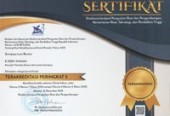CLIMATE CHANGE AND COMMUNITY ENVIRONMENTAL CONFLICTS: ARE THEY CORRELATED?
Abstract
Keywords
Full Text:
PDFReferences
Allen, Petter T. 1998. “Pubic Participation in Resolving Environmetnal Disputes and the Problem of Representation,” 9 Risk. p 297.
Angela Falconer, Skye Glenday, Anja Rosenberg and Jane Wilkinson. 2014. “Pemetaan Pendanaan Publik untuk Perubahan Iklim di Indonesia,” Climate Policy Initiative, available from: http://climatepolicyinitiative.org/publication/pemetaan-pendanaan-publik-untuk-perubahan-iklim-di-indonesia. (retrieved: Dec 19, 2016).
Atapattu, Sumudu. 2002. “The Right to a Healthy Life or the Right to Die Polluted?, The Emergence of a Human Rights to a Healthy Environment Under International Law”. 16 Tul. Envil. L. J.
Barnett, J. 2001. Security and Climate Change. Working Paper 7. Tyndall Centre for Climate Change Research, Norwich.
Brummans, Boris H. J. M., Linda L. Putnam, and Barbara Gray. 2008. “Making Sense of Intractable Multiparty Conflict: A Study of Framing in Four Environmental Disputes,” Communication Monographs, Vol. 75, Issue 1.
Bulland, Robert D. 2000. Dumping in Dixie: Race, Class, Environmental Quality, 3rd Edition, West View Press.
Presiden Jokowi Hadiri Konferensi Perubahan Iklim Dunia di Paris Perancis, http://www.harianregional.com/2015/12/presiden-jokowi-hadiri-konferensi.html (retrieved: Aug 26, 2016).
Crable, S. 1993.“ADR: A Solution for Environmental Disputes”. Arbitration Journal, 48(1).
Crawfoot, James E., and Julia M. Wondolect. 1990. Community Involvement in Conflict Resolution, Washington DC, Covelo California: Island Press.
Darpo, J. 2009. Environmental Justice through Environmental Courts? Lessons Learned from the Swedish Experience. In Jonas Ebbesson and Phoebe Okowa (Ed), Environmental Law and Justice in Context, New York: Cambridge University Press.
Demin, C., and D. Zhengaia. 2008. “Environmental Rights: on the Perspective of Harmoniousevelopment between Human Beings and Nature”, Law School of Chongqing University, Chongqing 400044, China 18 (1) China Population, Resources and Environment.
Desgagne, R. 1995. “Integrating Environmental Values into the European Human Rights Convention”. The American Society of International Law, 89 A.J.I.L.
Gleditsch, N. P. 1998. “Armed Conflict and the Environment”. Journal of Peace Research, 35(3).
Hill, B. et al. 2004. “Human Rights and the Environment: A Synopsis and Some Predictions,” Geo. Int'l Envtl. L. Rev.16(359).
Homer-Dixon, Thomas F. 1994. “Environmental Scarcities and Violent Conflict: Evidence from Cases”. Peace and Conflict Studies Program, University of Toronto, International Security, Vol. 19, No. I (Summer).
Jiang, Chong, and Linbo Zhang. 2015. “Climate Change and Its Impact on the Eco-Environment of the Three-Rivers Headwater Region on the Tibetan Plateau, China,” Int. J. Environ. Res. Public Health; doi:10.3390/ijerph121012057.
Klare, M.T. 2001. Resource Wars: The New Landscape of Global Conflict. New York: Metropolitan.
Levy, M. 1995. “Is the Environment a Nnational Security Issue?”. International Security, 20(2).
Liu, Yang; Saitoh, Sei-Ichi; Igarashi, Hiromichi; Hirawake, Toru. 2014. “The Regional Impacts of Climate Change on CoastalEnvironments and the Aquaculture of Japanese Scallops in Northeast Asia: Case Studies from Dalian, China, and Funka Bay, Japan,” International Journal of Remote Sensing.Vol. 35 Issue 11/12.
Mahe, G.; Lienou, G.; Descroix, L.; Bamba, F.; Paturel, J. E.; Laraque, A.; Meddi, M.; Habaieb, H.; Adeaga, O.; Dieulin, C.; Chahnez Kotti, F.; Khomsi, K. 2013. “The Rivers of Africa: Witness of Climate Change and Human Impact on the Environment,” Hydrological Processes. Vol. 27 Issue 15.
Marcia, Creary. 2013. “Impact of Climate Change on Coral Reefs and the Marie Environment,” UN Chronicle.Vol. 50 Issue 1.
Michael Case, Fitrian Ardiansyah, Emily Spector, Climate Change in Indonesia Implications for Humans and Nature, WWF(in http://assets.panda.org/downloads/ino...) (Retrieved: January 12, 2017).
Nicholson, D.F. 2009. Environmental Disputes Resolution in Indonesia. Leiden: KITLV Press.
Pebriansyah Ariefana, “Dampak Perubahan Iklim di Indonesia yang Sudah Terasa” (30 Oct 2015), available from:http://www.suara.com/news/2015/10/30/060600/dampak-perubahan-iklim-di-indonesia-yang-sudah-terasa. (retrieved: Jan 29, 2016).
Popovic, N.A.F. 1996. “In Pursuit of Environmental Human Rights: Commentary on the Draft Declaration of Principles on Human Rights and the Environment”.27 Colum. Human Rights L. Rev.
PPN dan Bapenas. 2013. Rencana Akasi Nasional, Adaptasi Perubahan Iklim (RAN-API): perubahan Iklim dan Dampaknya di Indonesia.
Raleigh, Clionadh., Henrik Urdal. 2007. “Climate Change, Environmental Degradation and Armed Conflict,” Political Geography, 26.
Rener, M. 1996. Fighting for Survival: Environment Decline, Social Conflict, the New Age of Insecurity. Environmental Alert Series. New York: Norton.
Sahnoun, Mohammed. "Environnement et Développement", Revue Algérienne des Relations Internationales, No. 8, 1987, OPU, Algies in: Mrs. Fatma Zohra Kesentini Report in E/CN.4/Sub.2/1994/9 6 July 1994.
Straus, D. B. 1978. “Mediating Environmental Disputes”, Arbitration Journal, 33(4).
Talbot, A. R. 2004. Settling Things: Six Case Studies inEnvironmental Mediation, Published by the Conservation Foundation and the Ford Foundation, 2nd printing.
The 1982 Law No.4 on the Basic Provisions on Environmental Management.
The 1997 Law No. 23 on the Environmental Management.
The 2009 Law No. 32 on the Environmental Protection and Environmental Management.
Wentz, Jessica. 2015. “Assessing the Impact of Climate Change on the Built Environment,” Environmental Law Reporter: News & Analysis. Vol. 45 Issue 11.
DOI: http://dx.doi.org/10.28946/slrev.Vol1.Iss1.9.pp067-079
Refbacks
- There are currently no refbacks.

Sriwijaya Law Review (SLRev) ISSN: 2541-5298 | e-ISSN: 2541-6464 is licensed under a Creative Commons Attribution-ShareAlike 4.0 International License.






















